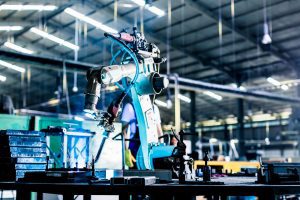Robotics has long been a field of fascination, but recent advancements are accelerating its integration across industries. Humanoid robots are enhancing manufacturing, while medical robots are refining precision surgery. Soft robotics are transforming agriculture, and AI-powered robots are reshaping logistics and warehouse automation. With continued innovation, robotics is poised to drastically improve efficiency, sustainability, and safety. This article explores the various sectors where robotics is making an impact, supported by real-world examples and case studies.
1. Humanoid Robotics in Manufacturing: A Step Toward Automation

Overview
Humanoid robots are designed to replicate human-like movements, making them ideal for working alongside humans in various environments. One of the most significant advancements in this area is the use of robots like Digit, developed by Agility Robotics. Schaeffler, a German industrial manufacturer, is among the first to implement Digit in their operations, planning its deployment across 100 global plants by 2030.
Benefits
- Improved Efficiency: Humanoid robots can handle repetitive tasks such as moving items, reducing downtime, and increasing throughput in manufacturing.
- Cost-Effective: Over time, humanoid robots can reduce labor costs and mitigate the challenges associated with labor shortages, particularly in sectors like logistics and assembly lines.
Real-World Example
Schaeffler’s Deployment of Digit: Schaeffler’s deployment of Digit reflects a major shift toward robotics in manufacturing. The robot is capable of navigating complex environments, delivering parts, and interacting with other systems, enabling Schaeffler to streamline their supply chain processes. The flexibility and human-like capabilities of Digit offer advantages in environments that are traditionally difficult for machines to navigate, such as factories with intricate layouts.
2. Advancements in Medical Robotics: Precision and Minimally Invasive Surgery
Overview
Medical robotics is one of the most promising fields, providing solutions that improve patient outcomes through precision and minimally invasive procedures. Companies like Johnson & Johnson are at the forefront, with their Ottava surgical robot recently receiving FDA approval to begin clinical trials in the U.S. In addition to improving surgery, robotics is also expanding into fields like drug delivery, rehabilitation, and diagnostics.
Benefits
- Precision and Accuracy: Surgical robots enhance a surgeon’s ability to perform delicate procedures, with high levels of precision that reduce human error.
- Minimally Invasive Procedures: Robots can operate with tiny incisions, leading to shorter recovery times, less pain, and lower risk of infection.
Case Study
Johnson & Johnson’s Ottava Robot: The Ottava system marks a significant leap in the capabilities of surgical robots. Its flexible robotic arms allow for enhanced precision during surgery, with the ability to perform tasks that would be difficult for human hands. With FDA clearance, this robot will assist in a variety of procedures, potentially revolutionizing the field of surgery by making it more efficient and less invasive.
3. Agricultural Automation: Robots Replacing Labor in the Fields

Overview
Robotics in agriculture is gaining momentum as farmers seek solutions to labor shortages and the need for increased efficiency. Soft robots like those developed by Fieldwork Robotics, in collaboration with Burro, are able to harvest crops like raspberries and tomatoes with a high degree of sensitivity, mimicking human dexterity.
Benefits
- Increased Yield: Robots can work around the clock, harvesting crops faster than human laborers and ensuring more produce is collected before it spoils.
- Minimizing Crop Damage: Robots equipped with soft grippers can handle delicate fruits and vegetables, reducing the risk of damage compared to manual harvesting.
Example
Fieldwork Robotics and Raspberry Harvesting: Fieldwork Robotics’ autonomous system is a prime example of how technology can address labor shortages in agriculture. This system uses robotic arms to gently pluck ripe raspberries, a task traditionally requiring skilled labor during the harvest season. By automating this process, farms can achieve greater efficiency and reduce reliance on seasonal workers, which is particularly important in regions with labor shortages.
4. Warehouse Automation: Enhancing Logistics with Mobile Robots

Overview
Warehouse automation has been revolutionized by mobile robots, such as those deployed by Brightpick and Symbotic. These robots are used to streamline inventory management, pick and pack orders, and optimize storage. The systems use AI to increase speed and accuracy, greatly benefiting large distribution centers that handle high volumes of goods.
Benefits
- Speed and Efficiency: Automated robots can process orders much faster than human workers, ensuring quicker turnaround times and reducing operational delays.
- Accuracy: AI-powered robots are less prone to human error, ensuring that the right products are picked and packed for shipment.
Case Study
Symbotic’s Deployment at Walmex: Symbotic, a leader in warehouse automation, has deployed its robots at Walmex’s distribution centers. These robots help automate the entire order fulfillment process, from sorting products to managing inventory. By integrating AI and mobile robots, Symbotic significantly reduces labor costs and improves operational efficiency in one of the largest retail chains in Latin America.
5. Industrial Welding Automation: Filling Gaps in the Workforce
Overview
Welding is a skill that requires precision and consistency, making it an ideal task for automation. Path Robotics has raised $100 million to develop autonomous welding robots, addressing the shortage of skilled workers in manufacturing and improving welding processes.
Benefits
- Consistency: Robotic welders provide consistent, high-quality welds, ensuring products are built to last.
- Safety: By removing humans from hazardous environments, welding robots improve worker safety.
Example
Path Robotics’ Autonomous Welding System: Path Robotics’ welding robots use AI to adapt to different welding tasks, ensuring that each joint is welded with the required strength and precision. These robots are helping to address the growing demand for skilled labor in industries like automotive and aerospace, where quality control is critical .
6. Energy Efficiency in Robotics: A Step Towards Sustainability
Overview
As the demand for robots increases, so does the need for energy-efficient systems. ABB Robotics has introduced its Energy Efficiency Service to help manufacturers optimize the power consumption of their robots.
Benefits
- Reduced Operational Costs: Optimizing energy use reduces electricity bills, contributing to significant savings.
- Sustainability: By minimizing energy consumption, manufacturers can reduce their environmental impact, which is crucial in today’s climate-conscious world.
Example
ABB Robotics’ Energy Efficiency Service: ABB’s service provides manufacturers with tools to analyze and optimize the energy consumption of their robotic systems. By offering tailored solutions for different industries, ABB helps companies become more energy-efficient, reducing both costs and carbon footprints.
7. Advances in Autonomous Transportation: Self-Driving Vehicles for Urban Areas
Overview
The rise of autonomous vehicles has the potential to transform transportation networks. Waymo, Google’s self-driving car project, has expanded its autonomous taxi service to Los Angeles, providing rides to passengers without a human driver.
Benefits
- Safety: Autonomous vehicles can reduce accidents caused by human error, making roads safer.
- Convenience: Self-driving cars provide on-demand transportation, which is especially valuable in busy urban environments.
Case Study
Waymo’s Robotaxi Service in Los Angeles: Waymo’s expansion into Los Angeles marks a significant step forward for autonomous driving technology. The robotaxi service allows users to book rides using a mobile app, with no human driver involved. This service demonstrates how robotics can revolutionize transportation, making it more accessible, efficient, and safe.
Conclusion: The Future of Robotics
The rapid advancements in robotics are transforming industries in unprecedented ways. From humanoid robots improving manufacturing processes to micro robots revolutionizing medicine, the potential of robotics is limitless. As technology continues to evolve, we can expect even more innovative applications that will reshape the way we work, live, and interact with the world around us. The future is indeed robotic, and we are only scratching the surface of its vast possibilities.












